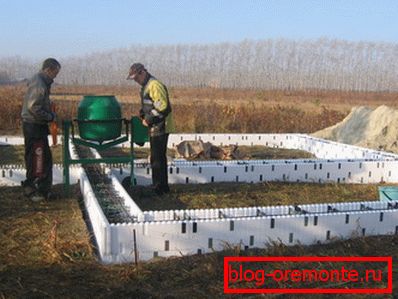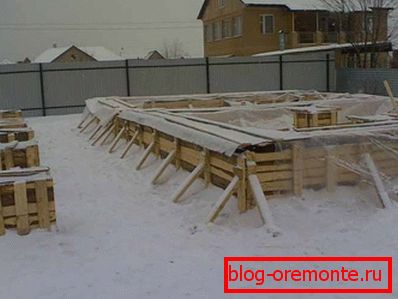Concrete freezing temperature: frost protection. transport
Often, concrete work has to be done in the winter, and the temperature regime for this process is very important, and many private developers are wondering - is it possible? When the temperature drops below the 3–4 degree mark, work with concrete mixtures should be stopped or appropriate measures should be taken. And what are these measures, and how effective they are, you will learn from our article.

Measures to protect the concrete from freezing
These subsidiary measures for the protection of concrete in cold weather include:
- Covering with warming with special protective materials.
- Heat treatment using heat guns, or the use of special electrical equipment.
Note! The composition of concrete mixes for working at low temperatures necessarily introduces special anti-frost additives - "non-freezing", affecting at what temperature freezes the concrete and accelerators hardening.

Additives are added to the mixture during its preparation.
The amount of additives can vary the expected effect:
- A content of 1–2% of the cement content gives an acceleration of concrete hardening.
- Accordingly, 3-5% of the freezing temperature of the concrete mixture is increased by 5-10 ° C.
- A share of 10–15% of the weight of the cement ensures complete elimination of the mortar freezing, however, it will increase the curing period by 40–90 days.
Very popular in construction as additives:
- Calcium chloride.
- Sodium chloride.
- Potash - potassium carbonate.
- Sodium Nitrite.
Note! The price of concrete mix with similar additives increases slightly, but, as you can see, even these small markups are worth using protective equipment.
In addition, in the cold season, it is better to use cements for the preparation of the mixture, which give a high heat generation during hydration. These include alumina binders, which, with proper shelter, will allow concreting to continue even at very low outdoor temperatures.

Control of the state of concrete
Since the process of hardening and a set of design strength of the cement mixture is quite long (under normal conditions 28 days), it is necessary to monitor and adjust the conditions. For control, a special device for measuring the temperature of concrete is used - the builder’s indispensable tool in winter.
Preparation and transportation of concrete
The instruction of conducting concrete work at low temperatures recommends starting monitoring the state of the mixture from the moment of its preparation:
- The mixing is done with heated water..
To avoid brewing the solution, the ingredients are introduced in the following order:
- First, water and large mineral aggregates.
- After the bay half of the required amount of fluid perform several turns mixer - concrete mixers.
- Now you can enter the cement with sand.
- Final mixing takes longer than in summer.
Tip! It is possible to reduce the number of revolutions of the concrete mixer by adding more hot water or thawed and heated gravel.
The use of different grades of cement requires different heating of water and provides at the same time approximately the same temperature of the concrete mix at the exit of the mixer:

- Portland cement, portland cement and pozzolanic brand slag cement below 600 at a water temperature of 80 degrees - the output of a mixture of 35 degrees.
- Fast hardening Portland cement and Portland cement M500 and more, respectively - water - 60 degrees, a mixture of -30 degrees.
- Aluminous cements - water about 40, a mixture - 25 degrees.
Note! When transporting the mixture, the main cooling of the concrete occurs not when the machine is moving, but when the mixer is rebooted. Therefore, direct deliveries to the place of laying concrete without delays at the stages of loading and unloading and without downtime in transit are recommended. The warming and heating of the container in which the mortar is transported is also welcomed.
Laying concrete mix
Conducting pouring mortar in the winter also has several features worthy of attention:

- Bases for laying heated concrete mix should be prepared to enhance adhesion:
- Cleared of snow, mud, ice.
- Heated to positive temperature at a depth of not less than 250-300 mm.
- Using a thermometer to measure the temperature of the concrete, the laboratory technician on duty immediately proceeds to exercise control over the laying process.
His job is to track the compliance of the holding temperature in the formwork or heating (if necessary):
- Estimated rate - for keeping the method of a thermos.
- The freezing temperature of concrete plus 5 degrees - for mixtures containing antifreeze additives.
- Not lower than zero degrees in the coolest places before electric heating begins.
- Plus 2 degrees in the case of other methods of heating the mixture.

Measurement of the temperature of the poured cement is carried out through the wells in his body, protected by insulating plugs. Wells are arranged in problem areas and strictly numbered, for a schematic display on the measurement drawing.
Permissible immersion in the wells of metal flasks partially filled with oil. To perform measurements, lower the thermometer for 3-7 minutes, isolating it from outside air. Measurement data is recorded in a temperature log.
- Excessive heat loss can be avoided by laying the mixture in layers in small areas and moving on to cover the grab with ready-made mats or shields.
- Concrete work in cold weather is carried out around the clock until the completion of the structure casting.
- The open part of the surface should be immediately insulated immediately after the completion of concreting..
Note! If for some reason the mixture in the working joint freezes, this area should be warmed up and the frozen element removed. And only after careful processing of this site, according to the recommendations of the SNiP, continue concreting.
To avoid all the difficulties of working with concrete in the cold on building a house with your own hands, you can wait for more favorable weather. Taking into account the fact that the solution will have to be left alone for almost a month before continuing the erection of enclosing structures on the flooded foundation, the best period must be adjusted - not cold, but not too hot.

Conclusion
Unfortunately, not everyone has the opportunity to wait for a warm time, so you have to do all the concrete work at sub-zero temperatures. The above information will help you to take into account all the pitfalls of this process, facilitate your work and save in the future on the repair of the elements responsible for the strength of the structure.
In the presented video in this article you will find additional information on this topic.